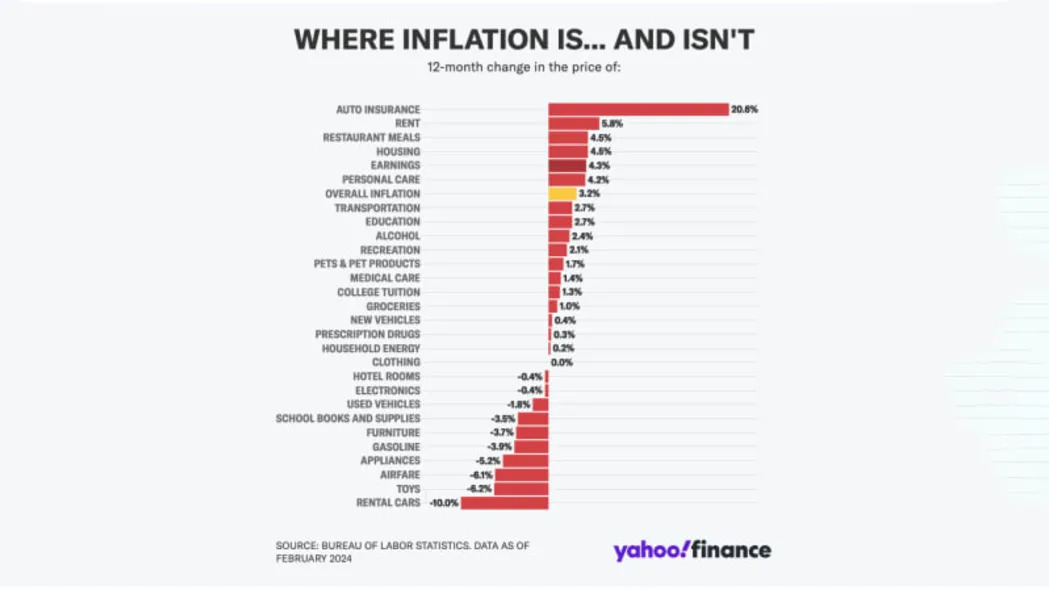If cruising the highway is an American birthright, it's also become an expensive one.
The cost of owning and operating a car has skyrocketed in the aftermath of the pandemic. And just as one element of car ownership has gotten more affordable, another is now wrecking the budget.
The latest pinch for drivers is the cost of auto insurance, which is up 20.6% year over year as of February — the biggest jump in the cost of car insurance in government data going back to 1985. It's also the biggest price jump for February in the 28 categories Yahoo Finance has been tracking since 2021.

Car insurance doesn't get nearly as much attention as headline items such as food, gasoline, and rent.
Yet it's now one of the few spending categories keeping the overall rate of inflation stubbornly high.
Overall inflation is down sharply from the peak of 9% in June 2022. But it ticked upward from 3.1% in January to 3.2% in February, causing fears that inflation may not be on the way out, after all.
Car insurance accounts for 2.5% of the basket of goods and services the government measures when calculating the overall rate of inflation and is among categories counted towards the "core" inflation measure — which strips out food and energy — that the Federal Reserve keeps a close eye on. Core inflation rose 0.4% over the prior month in February and 3.8% over the prior year.
Drop Rick Newman a note, follow him on Twitter, or sign up for his newsletter.
Insurance now costs the typical car owner $212 per month, or $2,545 per year, according to Bankrate.
For buyers who take out a loan, the typical monthly payment is about $530 for a used car and $740 for a new model. Insurance boosts the monthly cost of ownership by 25%-40%, money some buyers forget to account for when making a purchase.

The other thing keeping inflation high is the cost of housing, with the index for shelter, another element of core inflation, rising 5.7% year over year. Shelter costs, the BLS said, account for over two-thirds of the increase in core inflation over the last year.
Other important items, however, are heading in the right direction, such as groceries, up just 1% year over year. And some things are actually getting cheaper, including appliances, electronics, and toys.
No single cause
Frustratingly for consumers, there's no single cause for spiking insurance rates.
COVID-related supply chain challenges have created a shortage of new vehicles during the last few years, pushing up prices, which in turn pushes up the cost of repairs. Modern vehicles are also stuffed with electronics and other systems that make them costlier to fix.
Americans also appear to be driving faster, which makes crashes worse. All of this raises insurance costs.
And as anybody who has tried to buy a car lately knows, this comes after a huge run-up in car prices that changed the affordability equation for many drivers.
Year-over-year price hikes for new cars hit 13% in 2022 while used car inflation exceeded 40%. A shortage of semiconductors and other components slashed the output of new cars in 2021 and 2022, which pushed a lot of buyers into the used car market, accounting for unprecedented inflation.
Car prices have moderated as supply shortages eased, but overall prices are still way higher than pre-COVID levels. New car prices are 21% higher than they were four years ago, right before the COVID outbreak. Used car prices are up 31%.
The average cost of a new car is now $47,401, according to Kelley Blue Book. — though J.D. Power just calculated that the average transaction price took a $4,700 drop last month. The typical used car lists for nearly $26,000.
Fueling a car is no bargain, either. Gasoline prices are down about 4% year over year to around $3.40 per gallon. But gas is still 32% more expensive than four years ago, and some drivers are still fuming about prices that hit $5 per gallon in 2022, the highest nominal price ever in the United States.
There are a few bright spots, especially for buyers who can afford to be patient, however.
A glut of electric vehicles is causing double-digit price drops for some models, including Teslas, which seems likely to continue. Gas prices in 2024 could be a bit lower than in 2023. And transaction prices, though high, have dipped during the last few months, which should continue as automakers get back to more normal production levels.
Rick Newman is a senior columnist for Yahoo Finance. Follow him on Twitter at @rickjnewman.
Read the latest financial and business news from Yahoo Finance

Sign in to post
Please sign in to leave a comment.
Continue